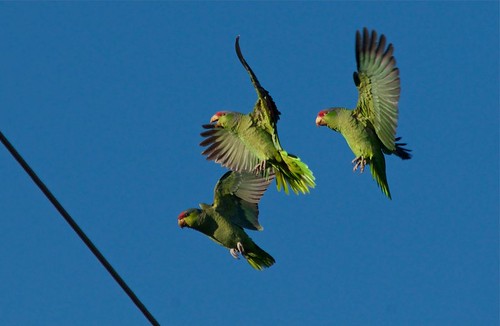 A wild parrot gets a belly full of delicious flora. The parrot populations have returned to the beach communities. Courtesy photo by Karen Straus, Audubon Society.The flocks of large, green-and-red birds around San Diego may seem unusual, but they’re a part of the beach culture now. They’re wild parrots.
A wild parrot gets a belly full of delicious flora. The parrot populations have returned to the beach communities. Courtesy photo by Karen Straus, Audubon Society.The flocks of large, green-and-red birds around San Diego may seem unusual, but they’re a part of the beach culture now. They’re wild parrots.
Though the parrots are not native to San Diego, or California as a whole, they’ve been here for a while and are likely here to stay. According to The California Parrot Project, the birds survive on seeds, fruit and nectar from tropical trees and shrubs planted in urban and residential areas in such communities as Ocean Beach, Point Loma, Pacific Beach and La Jolla.
Karen Straus, coordinator of the San Diego Bird Festival, hosted by the San Diego Audubon Society, said the birds do not migrate, but stay in San Diego year-round. They have established communal roosts around the county that they return to each night. During the day, the birds will fly out to a variety of food sources, depending on the time of year.
 Wild parrots take flight. They are being spotted again this year in Pacific Beach, Point Loma, Ocean Beach, La Jolla and other beach locations. Courtesy photo by Karen Straus, Audubon Society“I see them often out at Lakeside because there are trees in the Lindo Lake Park area that are a good food source for them,” Straus said. “So, at certain times of the year, they’ll be out at Lindo Lake, but they’re probably roosting back here [in the beach communities].”
Wild parrots take flight. They are being spotted again this year in Pacific Beach, Point Loma, Ocean Beach, La Jolla and other beach locations. Courtesy photo by Karen Straus, Audubon Society“I see them often out at Lakeside because there are trees in the Lindo Lake Park area that are a good food source for them,” Straus said. “So, at certain times of the year, they’ll be out at Lindo Lake, but they’re probably roosting back here [in the beach communities].”
She said the parrots have already made an appearance flying overhead at this year’s bird festival, and they’ve caused some excitement at festivals in the past.
“At the bird festival three years ago, they landed in the trees,” Straus said. “All our guests were running out of the workshops and running down to see the parrots right here at the festival.”
While there is no single explanation as to how the birds got here, Straus said there are two main theories, both of which may be true.
One is that the parrots came to California as pets.
“People like to have birds, especially parrots, as pets,” Straus said. “But sometimes, maybe there’s a behavior problem with the bird or maybe [the owners] are moving and they can’t take the bird with them, so the birds are simply released into the wild or the birds may escape into the wild.”
According to The California Parrot Project, hundreds of released and escaped parrots throughout the state over time have led to the wild, breeding populations today.
The other theory, Straus said, is that parrots native to northern Mexico came to California in search of a suitable habitat as areas of Mexico became deforested.
Whatever the reason, the exotic birds have established themselves as a colorful addition to more than 500 species of birds found throughout San Diego County.
“San Diego has an amazing diversity of birds, and that’s because we are lucky enough to be located on a major migration flyway,” Straus said.
Straus said anyone interested in learning more about the variety of birds in San Diego should go on a San Diego Audubon Society bird walk. Throughout the month experts guide guests through local areas around the county like Santee Lake and La Jolla Shores to observe birds.
For more information about the walks, visit www.sandiegoaudubon.org.